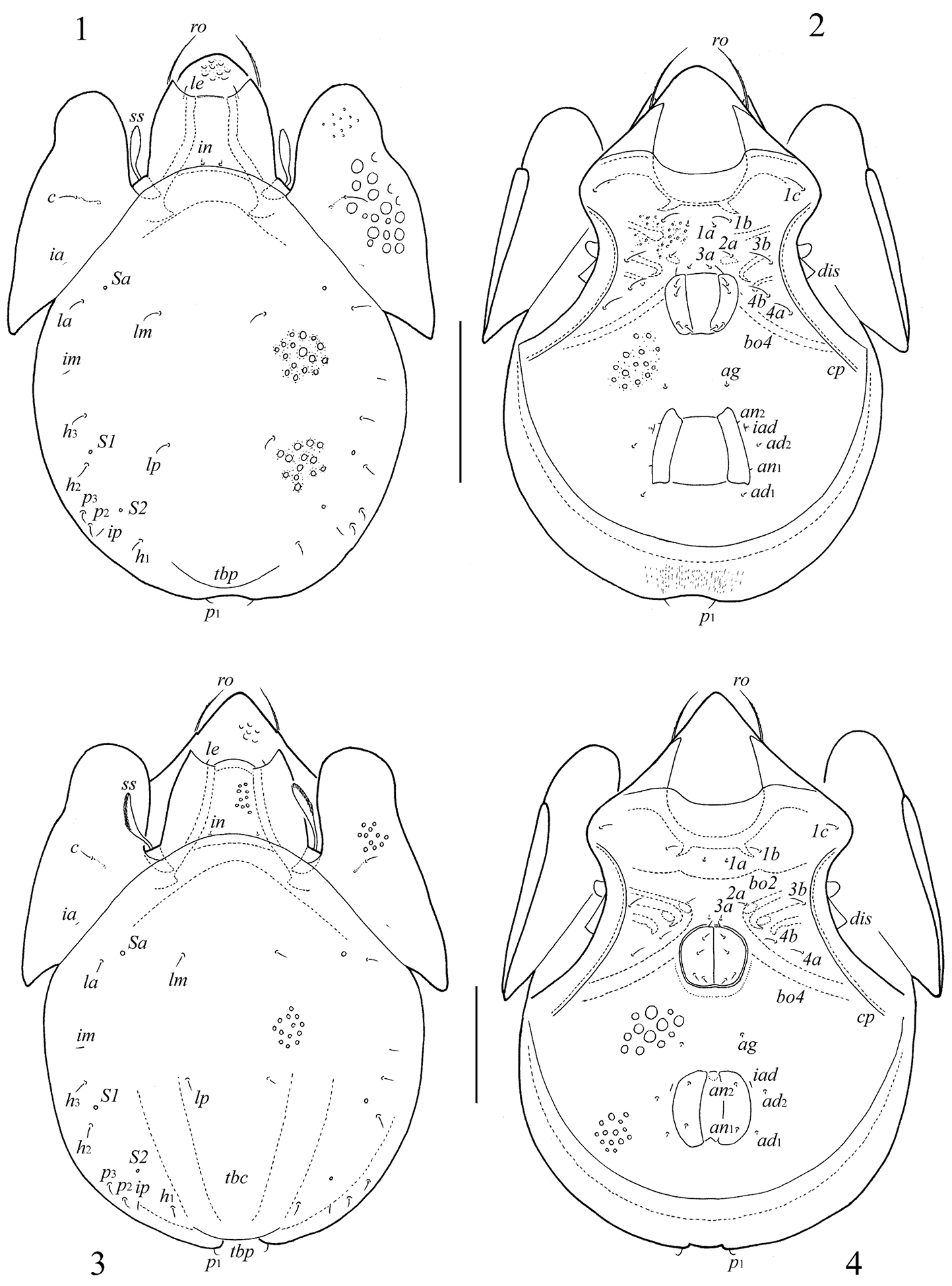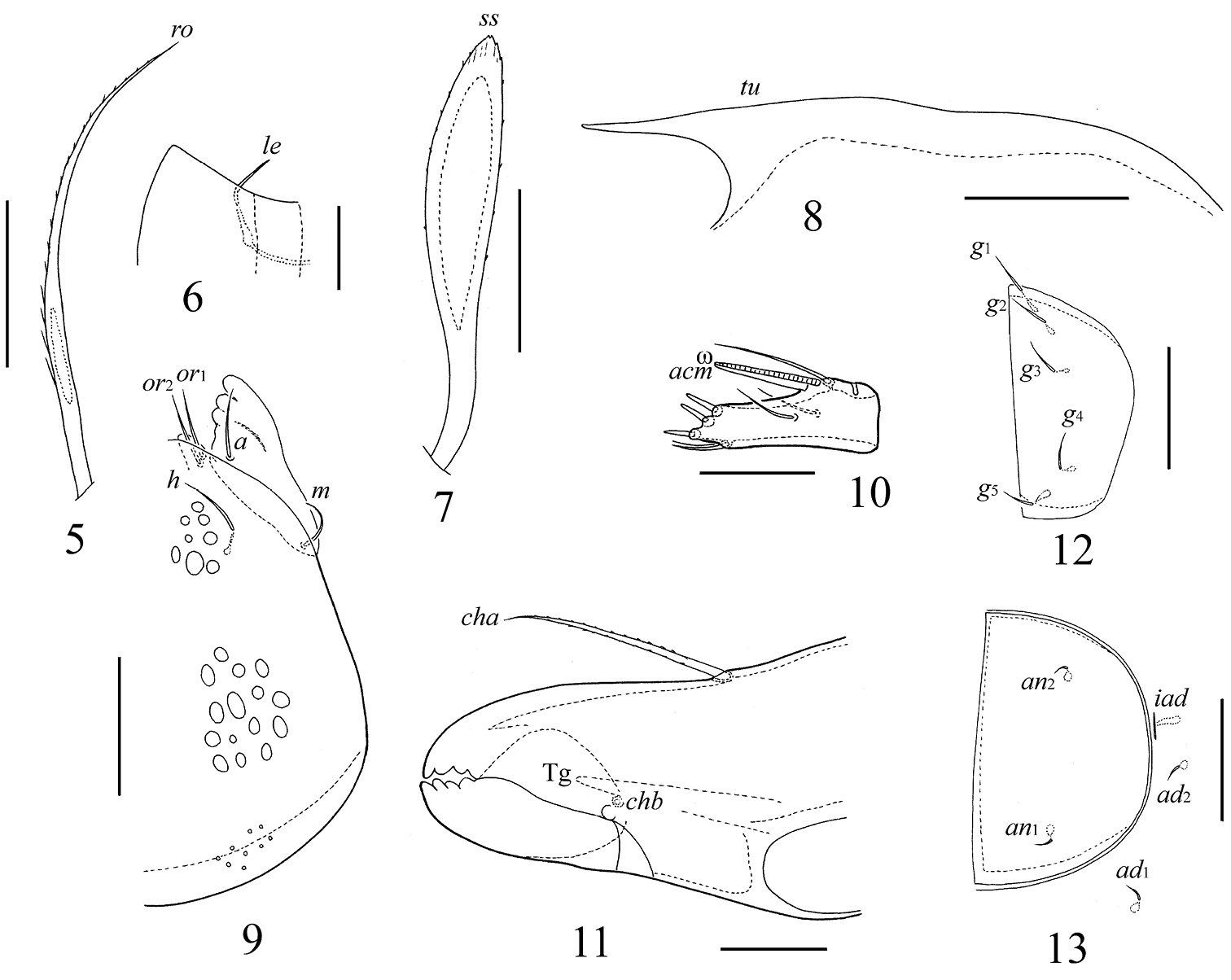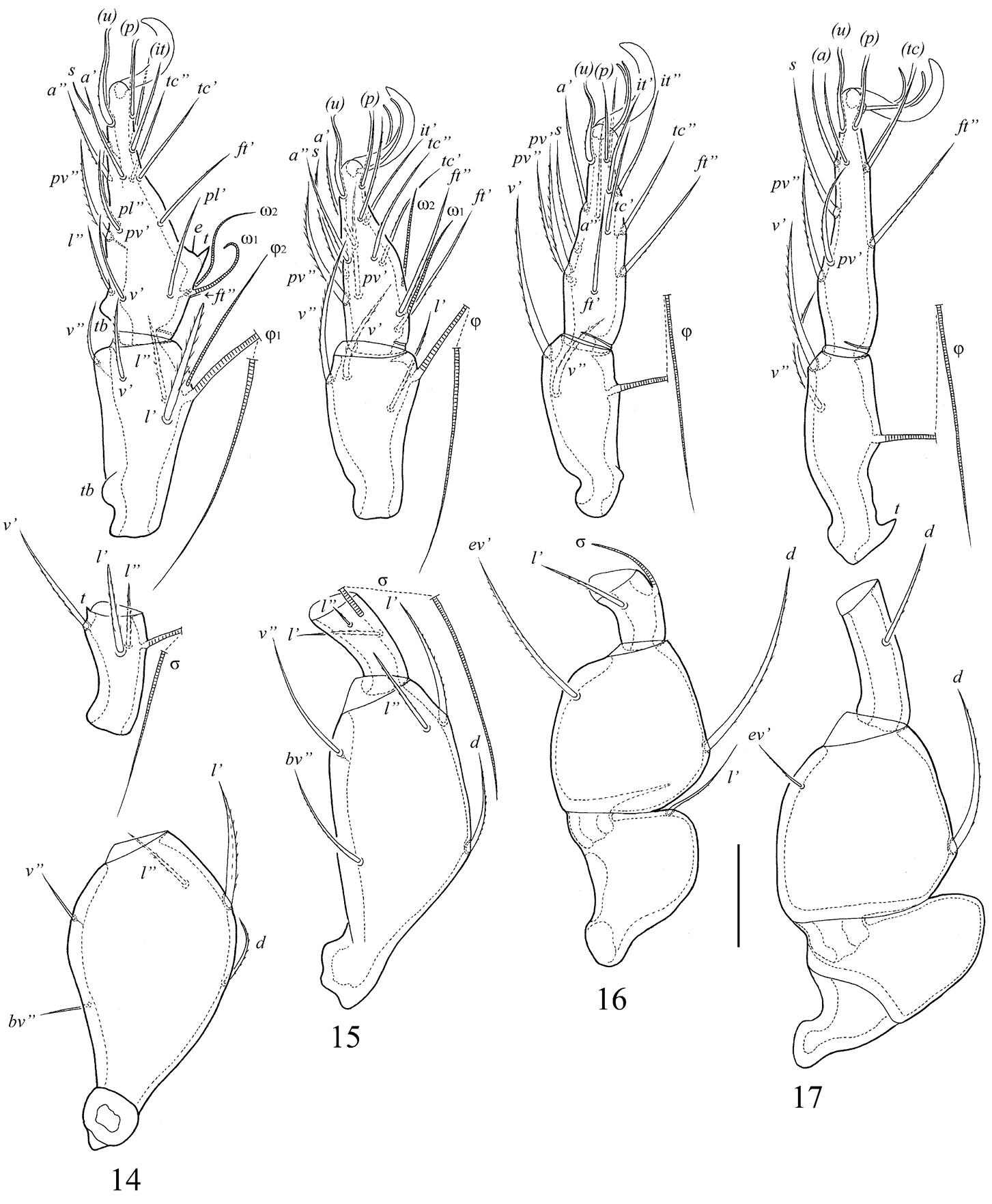






(C) 2013 Sergey G. Ermilov. This is an open access article distributed under the terms of the Creative Commons Attribution License 3.0 (CC-BY), which permits unrestricted use, distribution, and reproduction in any medium, provided the original author and source are credited.
For reference, use of the paginated PDF or printed version of this article is recommended.
Two new oribatid mite species of the genus Truncozetes (Oribatida, Epactozetidae), Truncozetes ecuadoriensis sp. n. and Truncozetes monodactylus sp. n., are described from the Ecuadorian soils. The morphology of the gnathosoma and the legs is presented in detail for the first time for the species of Truncozetes. An identification key to all known species of the family Epactozetidae is given.
Oribatid mites, Epactozetidae, Truncozetes, new species, key, Ecuador
Epactozetidaeis a small oribatid mite family of the superfamily Achipterioidea (Acari, Oribatida), comprising of two genera (Epactozetes Grandjean, 1930, Truncozetes Balogh and Mahunka, 1969) and five species, which are distributed in the Neotropical region.
Epactozetes is a genus that was proposed by
Truncozetes is a genus that was proposed by
During taxonomic identification of the Ecuadorian oribatid mite fauna, we discovered two new epactozetid species belonging to the genus Truncozetes. The main purpose of this paper is to describe and illustrate these species under the names Truncozetes ecuadoriensis sp. n.and Truncozetes monodactylus sp. n. The morphology of the gnathosoma and the legs is presented in detail for the first time for the species of the genus Truncozetes.
An identification key to all known species of the family Epactozetidae is provided.
Specimens were mounted in lactic acid on temporary cavity slides for measurement and illustration. Body length was measured from the side, i.e. from the tip of the rostrum to the posterior edge of the ventral plate. Notogastral width refers to the maximum width in dorsal aspect. Lengths of body setae were measured from the lateral side. All body measurements are given in micrometers (μm). Formulae for leg setation are given in parentheses according to the sequence trochanter–femur–genu–tibia–tarsus (famulus included). Formulae for leg solenidia are given in square brackets according to the sequence genu–tibia–tarsus.
General terminology used in this paper follows that summarized by
urn:lsid:zoobank.org:act:DF076204-3191-4390-89C5-D356720287A0
http://species-id.net/wiki/Truncozetes_ecuadoriensis
Figs 1, 2, 5–17Body size 315–332 × 215–232. Translamella thin, straight. Sensilli with weakly barbed elongate-oval head. Five pairs of genital and two pairs of anal setae present. Leg tarsus I monodactylous, leg tarsi II–IV tridactylous.
Measurements. Body length: 315 (holotype), 315, 332 (two paratypes); notogaster width: 215 (holotype), 215, 232 (two paratypes).
Integument. Body color brown. Surface covered by cerotegumental microgranules (visible under high magnification). Foveolae distinct, larger on pteromorphs (diameter up to 12).
Prodorsum. Rostrum widely rounded. Lamellae with lateral point anteriorly. Translamella very thin, straight. Rostral setae (ro) of medium size (41–45), setiform, barbed. Lamellar (le, 6–8) and interlamellar (in, 2–4) setae short, thin, smooth. Sensilli (ss, 53–61) with short stalk and weakly barbed elongate-oval, head. Exobothridial setae and their alveoli absent. Tutotia (tu) knife-form, with long and sharp cusps, reaching insertions of rostral setae.
Notogaster. Weakly concave posteriorly. Posterior tubercle (tbp) poorly developed. Ten pairs of short (12–16), thin, smooth notogastral setae. Three pairs of small sacculi: Sa inserted antero-medially to setae la; S1 – antero-medially to setae h2; S2– antero-laterally to setae h1. Lyrifissures ia located on pteromorphs, but poorly visible; im– antero-laterally to setae h3; ip – postero-laterally to sacculi S2; ih and ips located in lateral positions. Opisthonotal gland openings not found.
Gnathosoma. Subcapitulum longer than wide (77 × 61). Subcapitular (h, m, a) and adoral (or1, or2) setae similar in length (12) setiform, smooth. Palps (61) with setation 0–2–1–3–9 (+ω). Solenidion (ω) thickened, straight, attached with eupathidium (acm). Chelicerae (77) with one setiform, barbed seta (cha, 24); possible chb also present, but we found only their alveolus in dissected specimen. Trägårdh’s organ (Tg) long, elongate conical.
Epimeral and lateral podosomal regions. Apodemal border 4 (bo4) complete, wide, brownish. Epimeral setal formula: 3–1–2–2. Epimeral setae short, setiform, smooth; 1a, 3a (2) shorter than 2a (8), 1b, 1c, 3b, 4a, 4b (12–16). Discidia (dis) triangular. Circumpedal carinae (cp) distinct.
Anogenital region. Five pairs of genital (g1–g5, 8), one pair of aggenital (ag, 2–4), two pairs of anal (an1, an2, 2–4) and two pairs of adanal (ad1, ad2, 2–4) setae short, setiform, thin, smooth. Lyrifissures iad located in paraanal position.
Legs. Tarsus I with one claw, tarsi II–IV with three claws. Dorsal side of tarsus I and dorso-proximal part of tibia IV with strong thorn (t); antero-ventral side of genu I with small thorn; ventral side of tarsus I and tibia I with large tubercles (tb). Formulae of leg setation and solenidia: I (1–5–3–4–20) [1–2–2], II (1–5–2–3–15) [1–1–2], III (1–2–1–2–15) [1–1–0], IV (0–2–1–2–12) [0–1–0]; homology of setae and solenidia indicated in Table 1. Famulus (e) thin, straight, inserted anteriorly to thorn. Setae barbed (except smooth p and s on tarsus I). Solenidia ω1 on tarsus I, ω1, ω2o n tarsus II, σ on genua III thickened, blunt-ended, other solenidia setiform.
Truncozetes ecuadoriensis sp. n. (1, 2) and Truncozetes monodactylus sp. n. (3, 4), adults. 1, 3 body dorsally 2, 4 body ventrally (gnathosoma and legs not illustrated). Scale bars: (1, 2) 100 μm, (3, 4) 50 μm. Abbreviations in text.
Truncozetes ecuadoriensis sp. n., adult. 5 rostral seta 6 lamellar seta and anterior part of lamella dorsally 7 sensillus 8 tutorium 9 subcapitulum ventrally, left part 10 palptarsus laterally 11 anterior part of chelicera 12 genital plate, left 13 anal plate, left. Scale bars: (5, 7–9, 12, 13) 20 μm, (6, 10, 11) 10 μm. Abbreviations in text.
Truncozetes ecuadoriensis sp. n., adult. 14 leg I (without trochanter), right, paraxial view 15 leg II (without trochanter), left, antiaxial view 16 leg III, right, antiaxial view 17 leg IV, right, antiaxial view. Scale bar: 20 μm. Abbreviations in text.
Leg setation and solenidia of Truncozetes ecuadoriensis sp. n. (same for Truncozetes monodactylus sp. n.)
| Leg | Trochanter | Femur | Genu | Tibia | Tarsus |
|---|---|---|---|---|---|
| I | v’ | d, (l), bv’’, v’’ | (l), v’, σ | (l), (v), φ1, φ2 | (ft), (tc), (it), (p), (u), (a), s, (pv), v’, (pl), l’’, e, ω1, ω2 |
| II | v’ | d, (l), bv’’, v’’ | (l), σ | l’, (v), φ | (ft), (tc), (it), (p), (u), (a), s, (pv), ω1, ω2 |
| III | l’ | d, ev’ | l’, σ | (v), φ | (ft), (tc), (it), (p), (u), (a), s, (pv) |
| IV | - | d, ev’ | d | (v), φ | ft’’, (tc), (p), (u), (a), s, (pv) |
Roman letters refer to normal setae (e to famulus), Greek letters to Solenidia. Single prime (‘) marks setae on anterior and double prime (“) setae on posterior side of the given leg segment. Parentheses refer to a pair of setae.
Holotype (male), two paratypes (male, female): Ecuador, 3°58'S, 79°50'W, Estación Científica San Francisco, 2000 m a.s.l., upper organic soil layer in mostly undisturbed rain forest, 01.04.2009, collected by F. Marian and D. Sandmann.
The holotype (in alcohol) is deposited in the collection of the Zoological Institute of the Russian Academy of Sciences, St. Petersburg, Russia; one paratype (in alcohol) is deposited in the collection of the Siberian Zoological Museum, Novosibirsk, Russia; one paratype (dissected) is in the personal collection of the first author.
The specific name “ecuadoriensis” refers to the country of origin, Ecuador.
The new species is clearly distinguishable from other known species of the genus Truncozetes by the different number of leg claws (leg I monodactylous, legs II–IV tridactylous versus all legs monodactylous or tridactylous). Additional distinctive characters of a new species with the other species of the genus can be found in the identification key given below.
urn:lsid:zoobank.org:act:C92C81FB-B822-44D3-899B-056490CC1C47
http://species-id.net/wiki/Truncozetes_monodactylus
Figs 3, 4Body size 232 × 166. Translamella concave medially. Sensilli with lanceolate head densely ciliated on dorsal side. Dorso-central part of notogaster with large tubercle. Five pairs of genital and two pairs of anal setae. All leg tarsi monodactylous.
Measurements. Body length: 232 (holotype and paratype), 166 (holotype and paratype).
Integument. Body color brown. Surface covered by cerotegumental microgranules (visible under high magnification). Foveolae distinct, small (diameter up to 6).
Prodorsum. Rostrum narrowly rounded. Lamellae with lateral point anteriorly. Translamella thick, concave medially. Rostral setae of medium size (24), setiform, barbed. Lamellar (4) and interlamellar (2) setae minute. Sensilli (32) with short stalk and elongate-oval head, which is densely ciliate on dorsal side. Exobothridial setae and their alveoli absent. Tutotia knife-form, reaching insertions of rostral setae.
Notogaster. Concave posteriorly. Dorso-central part convex, with elongate hump-like tubercle (tbc). Posterior tubercle (tbp) well developed. Ten pairs of short (8–12), thin, smooth notogastral setae present. Three pairs of small sacculi visible, but S2 poorly visible. Position of lyrifissures asin Truncozetes ecuadoriensis sp. n. Opisthonotal gland openings not found.
Gnathosoma. Similar to Truncozetes ecuadoriensis sp. n.
Epimeral and lateral podosomal regions. Apodemal borders 2 (bo2) and 4 (bo4) wide, fused medially, brownish. Epimeral setal formula: 3–1–2–2. Epimeral setae short, setiform, smooth; 1a, 3a (2) shorter than 2a (4), 1b, 1c, 3b, 4a, 4b (8). Discidia triangular. Circumpedal carinae distinct.
Anogenital region. Five pairs of genital (4), one pair of aggenital (2), two pairs of anal (2) and two pairs of adanal (2) setae short. Lyrifissures iad located in paraanal position.
Legs. Similar to Truncozetes ecuadoriensis sp. n., but all tarsi with one strong claw.
Holotype (female), one paratype (female): Ecuador, 3°70'S, 78°58'W, Bombuscaro, Podocarpus National Park, 1050 m a.s.l., upper organic soil layer in mostly undisturbed rain forest, 01.04.2009, collected by F. Marian and D. Sandmann.
The holotype (in alcohol) is deposited in the collection of the Zoological Institute of the Russian Academy of Sciences, St. Petersburg, Russia; one paratype (dissected) is in the personal collection of the first author.
The specific name “monodactylus” refers to the one claw on all leg tarsi.
The new species is clearly distinguishable from other known species of the genus Truncozetes by the monodactylous legs (versus all legs tridactylous or leg I monodactylous, legs II–IV tridactylous). Additional distinctive characters of this species from other species of the genus can be found in the identification key given below.
| 1 | Lamellae shorter than prodorsum, well separated, connected by translamella | 2 (genus Truncozetes) |
| – | Lamellae as long as prodorsum, fused or connected medio-anteriorly | 6 (genus Epactozetes) |
| 2 | All leg tarsi with one claw; apodemal borders II and IV fused medially; body size: 232 × 166 | Truncozetes monodactylus sp. n. (Distribution: Ecuador) |
| – | All leg tarsi with three claws or only leg tarsus I with one claw; apodemal borders II and IV not fused medially | 3 |
| 3 | Leg tarsus I with one claw, leg tarsi II–IV with three claws; genital plates with five pairs of setae; body size: 315–332 × 215–232 | Truncozetes ecuadoriensis sp. n. (Distribution: Ecuador) |
| – | All leg tarsi with three claws; genital plates with six pairs of setae | 4 |
| 4 | Dorsal notogastral setae lm and lp inserted in lateral position of notogaster, approximately in one longitudinal row with setae la and h3; distal part of sensillus dark; body size: 233–244 × 171–176 | Truncozetes rugosus Mahunka, 1998 (Distribution: Antilles) |
| – | Dorsal notogastral setae lm and lp inserted in dorsal position of notogaster; distal part of sensillus not dark | 5 |
| 5 | Epimeral region with distinct longitudinal stria; sensillar heads densely barbed; body size: 228 × 168 | Truncozetes mucronatus Balogh & Mahunka, 1969 (Distribution: Neotropical region) |
| – | Epimeral region without longitudinal stria; sensillar heads smooth; body size: 308–336 × 176–185 | Truncozetes sturmi Balogh, 1984 (Distribution: Neotropical region) |
| 6 | Lamellae fused medio-anteriorly; notogastral setae visible; body size: 235–270 × 180–235 | Epactozetes setosus Balogh & Mahunka, 1969 (Distribution: Neotropical region) |
| – | Lamellae connected medio-anteriorly; notogastral setae not visible; body size: 210–235 × 160 | Epactozetes imitator Grandjean, 1930 (Distribution: Central America) |
We cordially thank Prof. Dr. Badamdorj Bayartogtokh (National University of Mongolia, Ulaanbaatar, Mongolia) for valuable comments, and Dr. JenőKontschán (Hungarian National History Museum, Hungary) for help with in studying of the paratype of Truncozetes sturmi Balogh, 1984.
Oribatid mites were investigated as part of the Research Unit “Biodiversity and sustainable management of a megadiverse mountain ecosystem in South Ecuador”, subproject “Soil fauna: Diversity and functioning” headed by Mark Maraun and Stefan Scheu; financial support by the German Research Foundation is gratefully acknowledged (RU 816).


